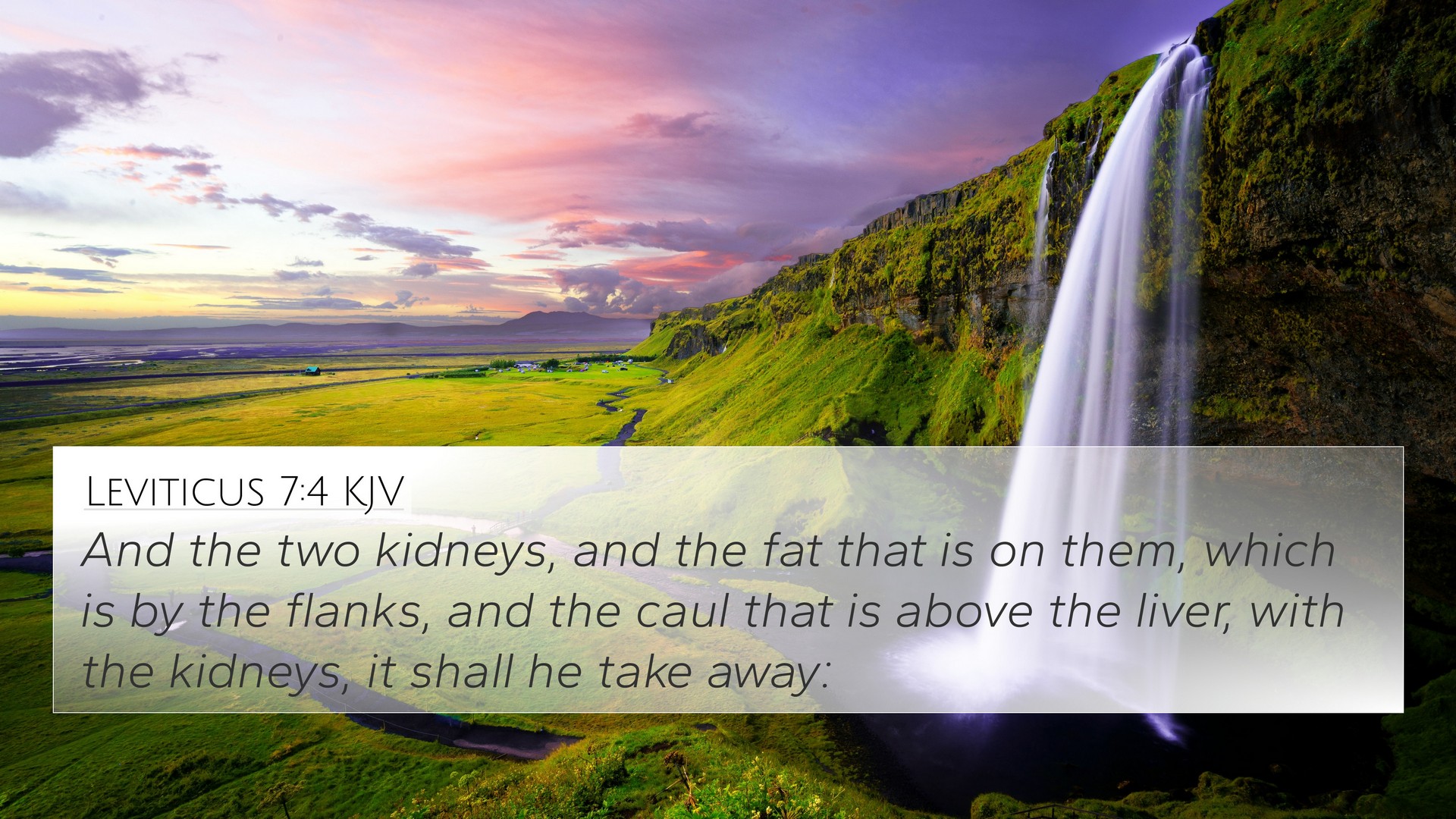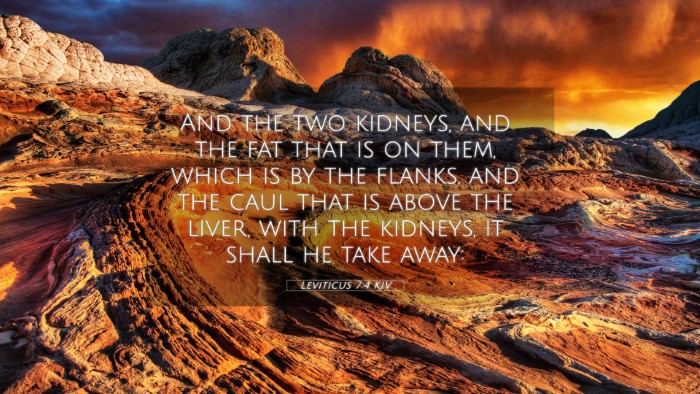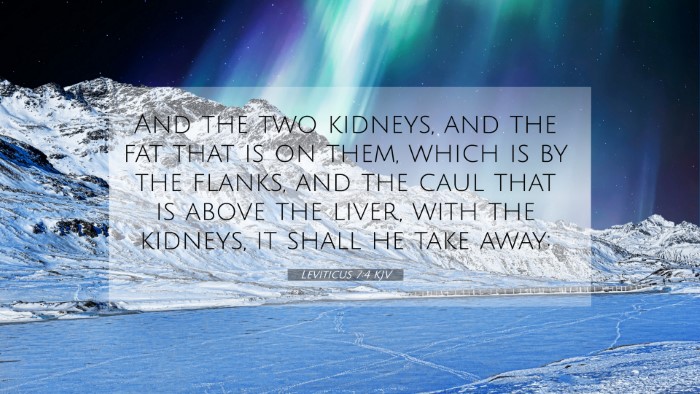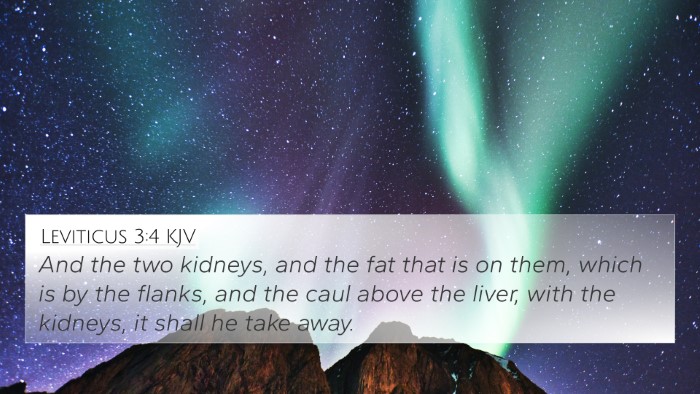Understanding Leviticus 7:4
Leviticus 7:4 states: "And the two kidneys, and the fat that is on them, which is by the flanks, and the caul that is above the liver, it shall he take away." This verse is part of the instructions regarding the peace offerings and provides insight into the sacrificial system and its significance in the covenant community.
Meaning and Significance
This verse outlines specific details for the preparation of certain animal sacrifices, emphasizing the ritual purity and the proper conduct expected in offerings to God. The kidneys, fat, and the caul above the liver are designated as portions to be removed and are significant for various reasons:
- Symbol of Offering: The kidneys symbolize the inner man, reflecting the purity that God desires in our enacting of worship.
- Fat as a Delicacy: Fat is often viewed as a delicate part of the sacrifice, representing the best and the choicest, which should be offered to God.
- Covenant Community Standards: The specifications serve to maintain the standards of holiness that are crucial in the relationship between God and Israel.
Commentary Insights
The insights from various public domain commentaries provide a deeper understanding of this verse:
- Matthew Henry: Henry emphasizes the importance of the fat and kidneys in the sacrificial system, relating it to God's commands which symbolize a need for inner purity and dedication to God.
- Albert Barnes: Barnes highlights the significance of the different parts of the animal being offered. He notes that the fat was considered sacred, and its removal points to God's sovereignty over all things.
- Adam Clarke: Clarke relates this passage to the broader sacrificial context, discussing the necessity of compliance with divine instructions in the offerings for the forgiveness and communion with God.
Bible Verse Cross-References
Leviticus 7:4 is interconnected with several other Bible verses. Here are some important cross-references:
- Leviticus 3:3-4: Discusses the fat being offered upon the altar, linking to ritual sacrifices.
- Exodus 29:13: Outlines the specific instructions regarding the sacrifices for priests.
- Deuteronomy 12:17-18: Addresses offerings made in specific places as a continuation of sacrificial practices.
- Hebrews 9:22: Highlights the importance of blood in the sacrificial system, connecting the Old Testament themes to the New Testament.
- 1 Peter 2:5: Relates to the offering of spiritual sacrifices, building on the sacrificial imagery from the Old Testament.
- Romans 12:1: Encourages believers to present themselves as living sacrifices, echoing the concepts found in Levitical law.
- Leviticus 7:29-30: Reiterates the importance of the sacrificial offerings and their consumption by the priests, establishing communal elements of worship.
Connections and Themes
This verse outlines several key themes that resonate through both the Old and New Testaments:
- Ritual Purity: Emphasizes the consistent theme of maintaining purity in approaching God.
- Divine Command: Highlights obedience to God's commands as a critical aspect of worship.
- Symbolism of Sacrifice: The elements detail what God regards as acceptable in sacrifices, foreshadowing Christ's ultimate sacrifice.
Cross-Referencing Bible Study
For those engaging in cross-referencing Bible studies, tools like a Bible concordance can be immensely helpful. Utilizing a Bible cross-reference guide to explore related scriptures can deepen the understanding of sacrifices in the context of biblical theology. Here are some methods and tools:
- Cross-reference Bible study: Use thematic or narrative connections to delve into scripture.
- Identifying connections between Old and New Testament: Pay attention to parallels regarding sacrifice and worship.
- Using comprehensive resources: A good concordance or Bible app with reference materials can provide insights on themes and key concept links.
Conclusion
In summary, Leviticus 7:4 serves as a vital piece in understanding the broader sacrificial system and its implications in biblical worship. By studying this verse alongside its cross-references, individuals can gain insight into the themes of purity, obedience, and the significance of sacrifice in both the Old and New Testament contexts. It challenges believers to reflect on how the principles of offering and inner dedication apply to their lives today.



